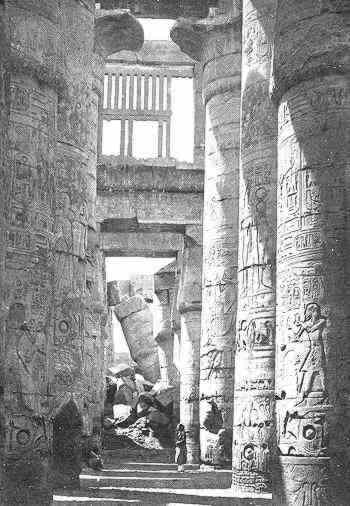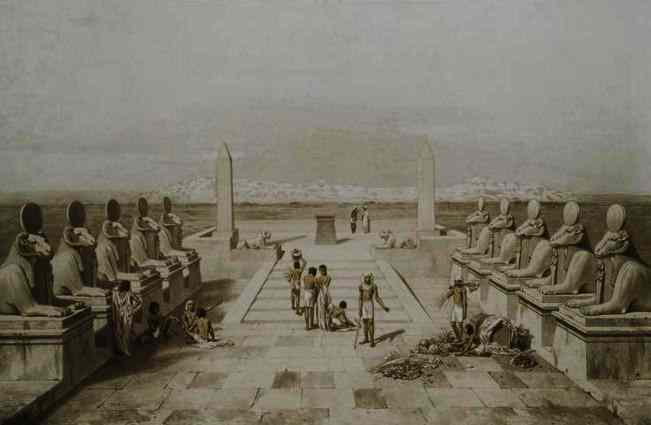AscendingPassage.com
See the: Egyptian Secrets Library

Ascending Passage
Mysteries In Stone
Ancient stone work of massive size is coming to light in places such as Malta, Baalbek (Lebanon), Machu Pichu (Peru) and Gobekli Tepe (Turkey) alongside the familiar Stonehenge of England. But all of those sites and other remnants of the past taken together, mass a tiny fraction of what remains to us of Egypt. For more than a thousand years Egypt was the weathiest nation in the world. Memphis, and then Thebes were the world's largest cities. Fortunately the Sahara Desert keeps safe what is given to it. We have much more from Egypt than from many later cultures.
Christopher Dunn is a professional engineer who has carried out numerous precision measurements in Egypt and Peru. In the debris near Cheop's Pyramid he found hard stone cut into complex machined forms difficult or impossible to duplicate today. The ancient stonecutters created surfaces as flat as those surfaced by the best modern machinery.
"Even the concept of this kind of precision does not occur to an artisan unless there is no other means of accomplishing what the artifact is intended to do.... (the 80 ton granite boxes of) the Serapeum would be extremely difficult to produce today. Their smooth flat surfaces, orthogonal perfection and incredibly small inside corner radii that I have inspected with modern precision straight edges, squares and radius gages, leave me in awe."
Christopher Dunn
This is directly in conflict with conventional understanding of these ancient times, but archaeologists are not trained in stone lathe work.

Calcite Bowl from the 3rd Dynasty
British Museum - Photo: EgyptArchive
Here is an archived link to some photos of precision cut stone vases and trays Christopher Dunn found in the Cairo Museum. When seen through an engineer's eyes they can be amazing: sunship.com (archived)

An old photo of the huge hall
of columns at Karnak, before restoration.
The scale here is astounding - that is a man down there at the bottom.
Ancient Megalithic Stoneworks
The Ancients have left us a number of puzzling sites using huge stones in their construction. The giant blocks they sometimes used in building temples and walls are exponentially more difficult to move and position than would be smaller stone blocks, yet in the most ancient times men moved and erected incredibly massive stones, with no reason for all the effort that we can understand.
The pyramids of Egypt are the largest stone structures in the world - other pyramids and the Great Wall of China have stone facing over dirt, which is far easier to construct. Most of the blocks used in the Egyptian pyramids' construction weigh about two tons. The stones of the King's Chamber of the Great Pyramid are 60 ton blocks of Aswan granite. The Gisa plateau is scattered with limestone blocks around 200 tons each, many are eroded as if by water. A few other sites in Egypt contain stones in the 60 - 100 ton range, notably the Osirion.

Moving the head of Ramesses II by Belzoni.
Pharaoh Ramses II built his funeral temple across the Nile from Thebes, now called the Ramesseum. For this, the most personal of his many temples, Pharaoh Rameses had a 1,200 ton statue of himself carved from a single block of Aswan granite quarried 200 miles to the south. For comparison, a loaded long haul truck with trailer weighs up to 60 tons.
The Persians knocked his statue over in 525 BC. The head of a smaller statue of the Pharaoh was carried off with great difficulty and now is in the British Museum.
Obelisks of Egypt

Re-creation of a Sun Temple
by Prisse d'Avennes (1878).

5th Dynasty, Abu Sir.

The earliest known obelisk is still in its original position marking the site of ancient Heliopolis. Heliopolis was the center of learning in Egypt from the early dynasties until the Greek-influenced Alexandria became more dominant. The site of Heliopolis is mostly unexcavated, whatever remains of the ruins are deep underground in a residential area of greater Cairo. It is quite possible that the priests withheld their knowledge from the Greek invaders, and perhaps, someday, great troves of long lost papyrus scrolls will be found at Heliopolis.
The 68-foot (20.7 m) 120 ton red granite Heliopolis Obelisk was erected by Senusret I of the XIIth Dynasty (1971-1926 BC).
Engraving by David Roberts, 1838.



Egyptian Pharaoh Queen Hatshepsut erected a 400 ton, 90 foot tall obelisk in Karnak (Thebes) around 1500 BC, probably the largest in Egypt. A second obelisk from her reign sits on it's side nearby.
There are several dozen obelisks in existence, over half are outside Egypt. Many of the obelisks were taken by the Romans, one is now in Central Park in New York City.
Obelisk engravings by Prisse d'Avennes, 1878.

Early Egyptian creation myth tells of a great sea. A mound of earth pushed into existence: the one became two. The pyramids reflected that original mound, as did the sun temples and obelisks that followed.
An Egyptian statue of a pharaoh was carved from a single stone. The spirit of the pharaoh was intended to inhabit the statue, a division would block this. The Egyptians built columns in manageable parts. Walls too have courses of stones. Divisions didn't matter for most things the Egyptians built.
Obelisks were always carved from a single stone. They embodied the Sun - Ra, and the Egyptians did not consider the relation symbolic. They went to enormous extra effort to build their obelisks the hard way.

Countless beautiful 19th century images of ancient Egypt
and 75 pages of architecture, art and mystery
are linked from the library page:

The Egyptian Secrets Library















